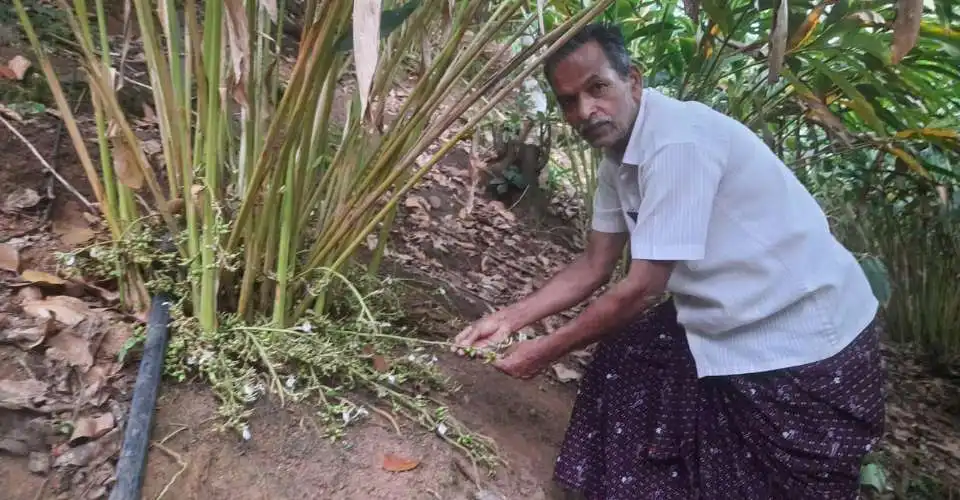
By Saji Thomas
IN picturesque Mavadi, a village in the hilly district of Idukki, the cardamom bowl of India in southern Kerala state, Thomas Kollikolavil is a worried man.
The 73-year-old Catholic cardamom farmer says that despite cardamom prices doubling in the past five years, his yield is insufficient to cover the expenses he incurred producing it.
“It is a challenging time for cardamom farmers now. We work hard and spend more money on pesticides and manure. But the yield has fallen drastically because of unexpected weather,” he says.
Kerala has an estimated 20,000 small-scale cardamom farmers like him, who cultivate the exotic but fragile spice plant on small plots of about two hectares (five acres) or less.
Kollikolavil planted some 800 plants two decades ago on almost one hectare of land near his home in the district, known for its good weather, which is ideal for sensitive cardamom cultivation.
Cardamom plants thrive in humid and warm climates with well-distributed annual rainfall of 1,500–2,500 mm at 600-1200 meters above sea level. The ideal temperature should be 10–30 degrees Celsius.
Rising mercury
“We’ve never experienced such high temperatures,” he said as the mercury in the area shot up to 33 degrees Celsius from a pleasant 22-25 degrees.
He said temperatures have been increasing over the years. “But we never expected it would reach this level and kill our plants, making farming impossible,” Kollikolvail added.
Most of Kollikolvail’s plants “yielded very little as they wilted in the summer heat” in April-May, one of the hottest summers in recent history.
Government estimates say that rising temperatures caused total crop losses on 16,211 hectares and partial crop losses on 13,349 hectares in the district this year.
According to an advanced estimate of the Spices Board of India, a federal regulatory and export promotion body, cardamom is planted on around 69,190 hectares in India and produced 22,520 metric tons in 2020-21.
Kerala accounts for 70 percent of India’s total cardamom production, followed by Karnataka (20 percent) and Tami Nadu (10 percent).
The government identified 22,311 small-scale farmers across India who were affected by summer heat. The worst-affected were in Idukki.
Falling yields
“It is true, cardamom cultivation has become increasingly difficult and costly due to the erratic climate,” says Cherian Joseph, a social worker in Valiyathovala, another village in the district.
Joseph, 65, who planted 650 plants three years ago, expected a bumper crop, but his hopes were shattered by twin tragedies — the extremely hot summer and a new menace — snails.
A cardamom plant begins to yield a crop in less than 22 months, provided it receives proper care, including a supportive climate, fertilizers, pest control, and adequate rain.
The best yields start in the third year, with July–December being the peak harvesting season. The plants give yields throughout the year, though in small quantities during off-peak periods.
On average, a farmer harvests at least one kilogram of dried cardamom from a plant during peak season. “It could be double that or more depending on the climate and care given to the plant,” Joseph said.
In ideal conditions, Joseph can earn at least 1 million rupees (some US$12,000) from his crop, as the price has risen to 2,500 rupees a kilogram.
“But I got only one-third of that. And that’s not enough to maintain the plants,” he adds. “If the climate were favorable, I would have had at least three harvests by now,” he told UCA News.
Fighting to survive
During summer, farmers must “protect the plants from heat and, in the monsoon season, from decay,” says Noby Sebastian, a cardamom farmer who also works for a private fertilizer company.
“The plants also suffer from different infections and any delay in dealing with such disease can wipe out an entire crop,” he adds.
A government official who wished to remain anonymous because he was not authorized to speak to the media told UCA News, “Obviously, climate change has negatively impacted cardamom production in several ways.”
He said the erratic temperatures and a decline in rainfall have led to increased pests and disease outbreaks, which increased the decay of roots and panicles.
When roots become weak with fungal infection, they automatically prevent a plant from absorbing fertilizers and other nutrition supplements, leading to its death.
Similarly, excess rain can lead to the panicles rotting, which can wipe out the entire crop. “These fragile plants are easy victims to different kinds of pests and they all need to be treated in time, failing which the crop will die,” he said.
Cardamom needs shade to withstand direct summer sunlight. Farmers generally plant cardamom under the shade of trees. However, when the sun is stronger, they place biodegradable nets above them as shade to protect them.
“We also irrigate the plants in summer to keep the soil cool for better crops. In some cases, farmers use drip irrigation and also spray water with hoses,” says Rejith A R, a Hindu cardamom farmer based in Narakakanam.
Soaring production costs
“All these are expensive and increase the production costs. The cost of pesticides and fertilizers has skyrocketed over recent years,” he says.
Joseph said the costs have increased not just because of the hot weather but also because of snails.
“Without any warming, farmers began facing a new enemy when snails appeared on the plantations. They remain hidden in the mud and wake up at night and eat the flowers on the panicles,” he said.
Joseph believes the snails are a result of climate change.
“Farmers are now struggling to control the new enemy” with chemicals. “We mix poison with cabbage and place it in various locations on the plantation, and it attracts snails. They eat this and they die,” he explained.
“The climate has hit us badly this summer, and now our challenge is to protect our crops from wild boars, parrots, rats, frogs, other animals and pests,” Rejith says.
“We are helpless with this menace to a certain extent as killing wild animals is a punishable crime,” he adds.
In addition to this, wages for the workers have also increased.
The majority of cardamom farmers in Kerala are dependent on migrant workers from central and northern Indian states and also from the neighboring state of Tamil Nadu.
Each laborer gets 900 rupees daily, as well as food, which is an additional cost.
No option
Joseph Noozhimuriyil, a farmer and former trustee of Christ Raj Parish Church in Valiyathovala, said that Kollikolavil “is a lucky man” compared to him.
“My 600 young and yielding cardamom plants dried up in this summer’s heat,” Noozhimuriyil told UCA News in October.
“This was my only source of income and I don’t know how to take care of myself and my family,” he said.
“Now the only option is to replant and wait for two years until they start yielding,” he said.
Noozhimuriyil said traditional farmers have not been insuring their plants as they are unaware of the insurance schemes.
Besides, farmers do not have easy access to insurance facilities in their villages. “Even the few aware of it don’t insure their plants because of the high premiums demanded.”
Many also question whether it is worth paying for insurance as those insured in the past received “compensation that wasn’t worthwhile” when their plants were destroyed, Noozhimuriyil added.
He and other farmers want the government to have an integral plan to help farmers and increase India’s cardamom production.
Until the early 1970s, India was the world’s top cardamom producer and exporter.
However, Guatemala in Central America holds that position now, having 55 percent of the total global production. Other major cardamom producers are Sri Lanka, Papua New Guinea, and Tanzania.
However, despite all the odds, people in the region depend on cardamom for survival, as there is no other cash crop they can gainfully cultivate in the region, Kollikolavil said. – UCA News






















































